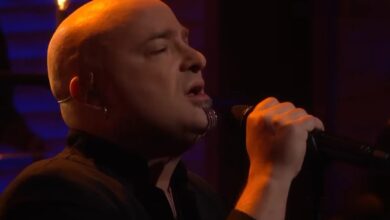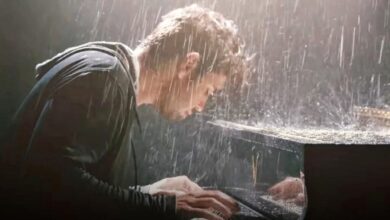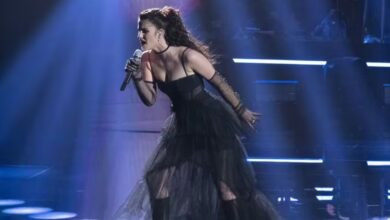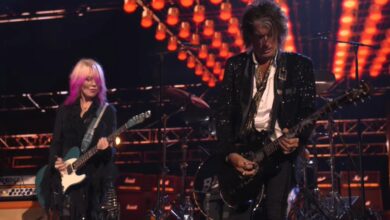Royal Marines Transform Pink Floyd Classic into a Masterpiece at Royal Albert Hall
The first hint that “Another Brick in the Wall” would be far more than a clever cover arrived the instant the Royal Albert Hall went midnight blue and the Corps of Drums stepped into diamond-cut formation. This wasn’t pub-band pastiche; it was the Massed Bands of His Majesty’s Royal Marines treating Pink Floyd’s anti-authoritarian chant like a ceremonial fanfare. A terse snare tattoo snapped the room to attention; low brass began to murmur the hook in regimented unison; then the melody climbed the hall’s famous dome like a searchlight. Phones rose, grins spread, and a thousand private “is this really happening?”s turned into one shared yes.
What made the moment immediately special was the arrangement’s point of view. Rather than mimicking the original’s sleek disco-rock engine, the Marines reframed the song as processional drama—part parade square, part stadium roar. The bass line moved like a column of troops; trumpets etched silver edges around the phrases; woodwinds threaded connective tissue so the chorus could arrive with ceremony rather than surprise. It felt both subversive and perfectly proper: a song that once snarled at the classroom now voiced itself from a band steeped in discipline, and the irony landed with a wink, not a wince.
From the outset, the Corps of Drums served as narrator. Rudiments spoke in clipped consonants, rolls hung in the rafters like mist, and every accent fell exactly where the Royal Albert Hall likes to bloom—right on the cusp between echo and impact. Side drums turned the heartbeat of rock into parade cadence without draining its blood. When the snare line shifted from martial taps to a tight, shimmering bed, the brass rode over it as if onto a runway, the music counting down not to rebellion but to lift-off. The hall, a seasoned co-conspirator, amplified every click.
Then came the color. Muted cornets gave the verse a sly, conspiratorial gleam; trombones shouldered the groove with a bounce that nodded to the original’s funk; clarinets and flutes flashed like camera bulbs on the syncopations. Instead of a single fat synth doing the heavy lifting, you heard an orchestra of timbres: velvet horns for warmth, bright trumpets for bite, euphoniums to pour honey in the cracks. The familiar melody didn’t just arrive—it paraded past, fully uniformed, with each section saluting in turn. The audience, half nostalgia, half curiosity, cheered both the tune and the tailoring.
The staging helped the story read at distance. Lighting cues moved from cold institutional whites—hello, schoolroom—to saturated magentas and cobalt blues as the chorus swelled, a visual narrative from rules to release. Camera direction for the official video leaned in: crisp close-ups on stick work, wides that showed the geometry of the ranks, pans that let you feel the melody ripple across brass choirs like wind over tall grass. The mix honored inner parts without burying the hook; you could hum along and still notice the filigree. It was documentary and spectacle at once.
Context matters, and Mountbatten Festival of Music crowds know to expect curveballs. The Marines’ annual three-night residency treats the Massed Bands like a West End pit orchestra with parade-ground posture, pairing patriotic set pieces with pop, film, and rock in arrangements that prefer wit to gimmickry. Slotting “Another Brick in the Wall” into that ecosystem made perfect sense: a global anthem, rebuilt with ceremonial swagger, presented in the round to a house that can turn whispers into weather. It’s where pageantry and playfulness meet—and where the Marines’ precision becomes the punchline and the point.
Musically, the architecture felt inevitable once you heard it. The bass motif marched in even quavers; percussion painted the bar lines in bold; and the chorus—“We don’t need no education”—arrived not as a shout but as a crest, brass stacked in tiered harmonies that climbed a step with each reprise. It’s a clever inversion: the lyric pushes back against rigidity, while the arrangement uses order to magnify release. That tension energized the room. The wall wasn’t torn down; it was re-imagined as a proscenium arch, framed by gleaming instruments and perfect posture.
Half the thrill was discovering how well the tune travels. Heard in this idiom, the groove becomes a strut, the minor-key weight turns regal, and those iconic guitar shadings transform into brass embroidery. When the melody hits its long notes, trumpets didn’t just hold pitch; they held space, letting the hall sing back. The audience—some in dress suits, some in band tees—met in the middle on the chorus, a gentle wave of heads and lips, the sort of communal hum that says a song has outgrown its era without losing its edge. Military polish, rock attitude; handshake complete.
The Marines also understand pacing. They didn’t rush the reveal or over-sell the gag. Verse, chorus, a small harmonic detour that opened a window on the woodwinds, a return with brass thicker and drums brighter—each pass through the form added another coat of lacquer. By the time the bridge figure arrived, the room had been tuned to the band’s dynamic grammar: eyes widen on the drumline’s stick-trick flickers, shoulders drop during horn pads, then everyone lifts together for the final shout. It’s choreography without choreography, learned in real time.
A separate pleasure was the way this performance now lives online. The official upload serves as a souvenir you can pause and rewind without losing the room’s bloom. You can watch that second verse again to clock the clarinet arpeggios, or freeze the cut where the cymbal choke lines up with the lighting snap, or jump to the final reprise to feel the brass crest land exactly on the wide shot. It’s production savvy turned public service: a front-row vantage delivered to anyone with headphones, preserving both the joke and the jaw-drop.
There’s a historical footnote worth savoring: the Marines have form when it comes to reimagining rock monuments. Their Mountbatten albums and videos slip Pink Floyd alongside Queen, Led Zeppelin, even stadium pop, not as novelty items but as exercises in orchestration and showcraft. “Another Brick in the Wall” appears in the Mountbatten Festival of Music 2017 releases, proof that this arrangement isn’t a one-off stunt but a chart with real legs, tested under lights, brought back by demand, and etched into the band’s modern canon. The paper trail matches the applause.
Listen closely and the arrangement’s little winks pop. A clipped, staccato echo where a guitar would normally smear; a tiny hemiola in the side drums to kick a phrase forward; a deliberately “school-bell” triangle ping tucked under a brass swell. None of it distracts; all of it adds flavor. The Marines’ best crossover charts work because they don’t parody the source—they converse with it. You leave humming the tune and bragging about the details, the way you might after a fine dinner: sure, the main course was fabulous, but did you taste that glaze?
As the final chorus climbed to its summit, the lighting warmed from cool institutional tones to a gold wash, and the melody returned wearing its most ornate uniform. Trumpets sat high but never harsh; horns shaded the corners; trombones added the noble weight that makes a big room feel smaller in the best way. The last chord parked itself right where the Albert Hall keeps its halo, and the applause came like a standing wave—part surprise, part gratitude, part “play it again.” A bow, a grin, the sense of a wall turned into a window.
Beyond the punchline, there’s meaning. Taking a song about resistance and refracting it through the prism of ceremonial music invites a broader read: that institutions and ideas can talk to each other without either one collapsing. The Marines respect the original’s sting but answer it with craft, showing that discipline can carry rebellion’s tune without diluting it. In an era that loves either/or, this was a glorious both/and—Pink Floyd by way of parade ground, swagger reconciled with symmetry, a chorus that says no sung by an ensemble that says yes to excellence.
And then, because Mountbatten shows are built like albums, the program moved on—film themes, bravura solos, the Corps of Drums party-piece—yet the room kept the aftertaste of that mash-up on its tongue. People filed out quoting the hook, replaying phone clips, arguing (gently) about whether the brass voicings or the drumline stole the night. The best festival moments become souvenirs you can hum; this one also became a talking point you could explain to your skeptical mate at the pub with a single sentence: “The Royal Marines did Pink Floyd—and it absolutely worked.”
Finally, the performance’s durability is measurable in streams and shares. The Marines’ channel racks up views from casual curiosity to band-room study sessions; the Mountbatten 2017 album slot keeps the chart in circulation for listeners who find it by accident while searching for Floyd, then stay for brass. That’s the quiet victory: a piece conceived for a specific hall and weekend becoming a portable calling card, proof that the Marines can trade in pageantry and pop with equal fluency. The wall held; the music walked through. Roll on the next curveball.





